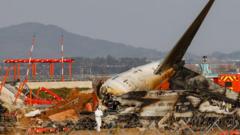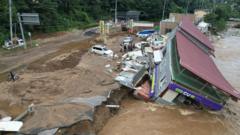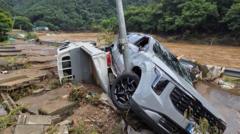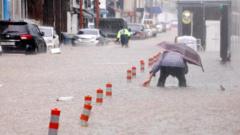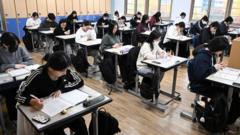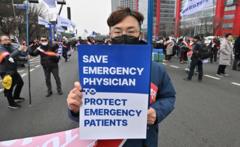In a harrowing turn of events, South Korea is reeling from the aftermath of catastrophic landslides and floods that have claimed at least 18 lives as torrential rain pounded the southern and western regions of the country. The nation’s disaster management office reported that rescue teams are still searching for nine individuals who are presumed missing as efforts to clear debris continue.
Landslides and Floods Devastate South Korea, Leaving 18 Dead

Landslides and Floods Devastate South Korea, Leaving 18 Dead
At least 18 fatalities have been reported as South Korea grapples with landslides and floods caused by unprecedented rainfalls, prompting emergency evacuations and a search for critical survivors.
In the last week, certain areas faced relentless downpours, with 31 inches of rain recorded in vulnerable provinces since last Wednesday. One of the hardest-hit locations was Sancheong County, where heavy rainfall led to ten confirmed deaths and four individuals unaccounted for; notably, a staggering 12 inches fell in just a single day on Saturday, prompting authorities to issue flood warnings to approximately 33,000 residents.
Eyewitness accounts from Sancheong revealed profound destruction, with floodwaters demolishing extensive strawberry greenhouses and tossing vehicles helplessly amongst the wreckage. Heartbreaking scenes unfolded as elderly community members surveyed their devastated homes, now dotted with large boulders washed in by the torrential floods. Reports indicated severe disruptions in essential services, including electricity and water supplies, compounding the residents' struggles.
Another tragic incident occurred in Gapyeong County, where a family camping trip turned fatal when a landslide overwhelmed their tent. While one son was rescued alive, his father’s body was later found downstream. Search efforts for the remaining family members—a mother and her 11-year-old daughter—continue amidst the challenging conditions of raging floodwaters.
The government stated that approximately 14,000 people were forced from their homes, with agriculture heavily impacted as fields across an area equivalent to 40,000 soccer fields were rendered unproductive. In addition, nearly 1.5 million livestock, including an overwhelming 1.4 million chickens, died in the disaster.
In response to the crisis, President Lee Jae Myung announced plans to designate the most severely affected districts as special disaster zones, enabling the provision of vital tax exemptions and other governmental assistance. As of Monday, with the rain subsiding and sunshine returning, many evacuated residents began returning to their homes, facing the daunting task of recovery amidst the destruction.
Rescue operations are ongoing, with military personnel assisting in clearing debris and removing damaged furniture. Although a heavy rain alert has been downgraded, further rain is anticipated in central and northern regions, raising additional concerns for more flooding and potential disease outbreaks due to the overwhelmed infrastructure.
As the community grapples with the devastation, regional authorities are poised to provide further support in the coming weeks as recovery efforts intensify.
Eyewitness accounts from Sancheong revealed profound destruction, with floodwaters demolishing extensive strawberry greenhouses and tossing vehicles helplessly amongst the wreckage. Heartbreaking scenes unfolded as elderly community members surveyed their devastated homes, now dotted with large boulders washed in by the torrential floods. Reports indicated severe disruptions in essential services, including electricity and water supplies, compounding the residents' struggles.
Another tragic incident occurred in Gapyeong County, where a family camping trip turned fatal when a landslide overwhelmed their tent. While one son was rescued alive, his father’s body was later found downstream. Search efforts for the remaining family members—a mother and her 11-year-old daughter—continue amidst the challenging conditions of raging floodwaters.
The government stated that approximately 14,000 people were forced from their homes, with agriculture heavily impacted as fields across an area equivalent to 40,000 soccer fields were rendered unproductive. In addition, nearly 1.5 million livestock, including an overwhelming 1.4 million chickens, died in the disaster.
In response to the crisis, President Lee Jae Myung announced plans to designate the most severely affected districts as special disaster zones, enabling the provision of vital tax exemptions and other governmental assistance. As of Monday, with the rain subsiding and sunshine returning, many evacuated residents began returning to their homes, facing the daunting task of recovery amidst the destruction.
Rescue operations are ongoing, with military personnel assisting in clearing debris and removing damaged furniture. Although a heavy rain alert has been downgraded, further rain is anticipated in central and northern regions, raising additional concerns for more flooding and potential disease outbreaks due to the overwhelmed infrastructure.
As the community grapples with the devastation, regional authorities are poised to provide further support in the coming weeks as recovery efforts intensify.

